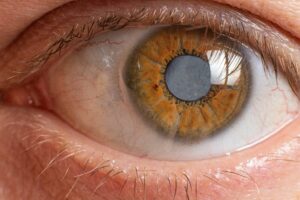Knowledge about smoking and your eye health

Cigarette smoke contains as many as 4000 toxic compounds, including tar, formaldehyde, carbon monoxide, and heavy metals. The surgeon general warns that even small amounts of smoking can damage your health immediately, and most people are now aware it causes lung cancer, emphysema, and cardiovascular disease, among many other problems. But many people don’t realize that smoking (or even frequent exposure to cigarette smoke), also affects your eye health, reducing the circulation to the eye and increasing chances of developing cataracts and age-related macular degeneration, in some cases leading to permanent blindness. Other studies also suggest a link between smoking and Graves’ ophthalmopathy, glaucoma, and diabetic retinopathy, among others.
Age-related macular degeneration (ARMD)
Perhaps the most common – and the most serious – threat to a smoker’s eye health, age-related macular degeneration is the leading cause of vision loss and legal blindness in Americans age 60 and older. ARMD affects the macula, the part of the eye that allows you to see fine detail. When the light-sensitive macula breaks down, it gradually destroys a person’s central vision – the vision needed to see objects clearly and used for common daily tasks such as reading or driving, or even recognizing faces.
Most often, the disease is associated with aging, but smoking causes damage to the macula, making ARMD much more likely to occur. In fact, with smoking the risk of developing ARMD doubles, but it may also increase by as much as four times, according to some studies. Doctors say the link between smoking and ARMD is as strong as the link between smoking and lung cancer, and the risk increases the more a person has smoked. The good news is that quitting smoking will drop your risk levels back down to nearly the same levels as non-smokers, especially after at least ten years of not smoking.
Cataracts

Like age-related macular degeneration, cataracts can occur naturally with aging – the lens of the eye grows cloudy over time, leading to blurry vision, faded colors, and increased glare sensitivity. Also like ARMD, smoking significantly increases the likelihood that they will develop, and at earlier ages than people who don’t smoke. There is conclusive evidence, from multiple sources, that smoking contributes to the formation of cataracts. Although it is not the only factor in cataract development, smoking does alter the cells of the lens through oxidation. Smokers double the risk of developing cataracts when compared to non-smokers, and the likelihood increases with heavy use – up to 2.9 times.
Other conditions and diseases
Glaucoma is a disease of the optic nerve – the part of the eye that carries images to the brain. It is known that smoking causes shrinkage or constriction of blood vessels, which damages the optic nerve.
Graves’ ophthalmopathy is an eye condition often associated with thyroid disease, characterized by inflammation of the eye and fat in the eye socket. Studies have found that for people who already have thyroid eye disease, those who smoke had poorer outcomes than non-smokers. Smoking also has been shown to increase the risk of developing thyroid disease.
Diabetic retinopathy, while not necessarily directly caused by smoking, seems to progress more quickly with smokers than non-smokers.
Dry eyes and other ocular surface disorders – conditions that cause itching, redness, and eye irritation – are linked with smoking, which is an irritant and reduces tear secretion, among other things.

Vaping
While vaping avoids some of the chemicals present in cigarette smoking, the nicotine and formaldehyde in “e-juice” can be even more concentrated. Vaping is more difficult to quit due to the convenience and high dosage of addictive chemicals. “E-juice” also includes chemicals not present in cigarettes. These additional chemicals lead to an increase in dry eyes due to a deterioration of the tear film, caused both by vapor getting into your eyes and the chemicals moving through your eyes from the bloodstream. These effects are on top of all of the previously mentioned symptoms of cigarette smoking. While vaping may seem more healthy, the reality is that it is just as bad, if not worse, than cigarettes for your eye health due to the way the chemicals are aerosolized.
You can read more about the negative effects of vaping HERE.
Marijuana

Marijuana is a more complicated substance, as there have not been many studies done on the overall and long-term affects of marijuana on eye health. But what is clear is that smoking marijuana negatively impacts lung health and increases dry eye issues. That is mostly due to smoke that gets in your eyes. So if you are using marijuana, strongly consider using an alternative delivery method to smoking, like CBD drops.
Another thing to consider in relation to marijuana is the use of redness-relieving eye (decongestant drops) drops. These are often taken to reduce the red eye effects of marijuana, but it is important not to use these too frequently – and not at all if you are at risk of narrow-angle glaucoma. Frequent usage can lead to “redness rebound,” where the eye becomes even more red and after a short period than before using the drops. For this reason, many eye doctors suggest trying preservative-free artificial tears instead.
Preventing smoke-related eye disorders
It’s never too late to quit smoking. The sooner you stop smoking, the better chance you have of preventing or delaying the onset of the eye diseases mentioned above. It can take up to twenty years of not smoking to achieve the same levels as those who never smoked, but no matter when you stop, you will get an immediate decrease in risk. It can be hard to stop, especially if you have tried in the past and it hasn’t worked. But you can do it.
Here are some things you can do to help yourself quit smoking:
- Set a quit date, and don’t buy cigarettes that will carry you past the last day.
- Throw your cigarettes and ash tray away – don’t make it easy to start smoking again.
- Get support from family and friends – ask them not to offer you cigarettes.
- Spend time with non-smokers – think of yourself as a non-smoker.
- Start an exercise program – fight weight gain, and your body won’t want the nicotine effects.
- Keep yourself busy – your hands may need occupation, and you may need to chew gum.
- Take on new activities – try new crafts or classes as a distraction, or go out with friends
- Join a quit-smoking program – support does help!
- Think about using nicotine replacements to help cut the craving, and taper off.
- Think about asking your doctor for prescription medicine such as bupropion (Zyban)
Contact Cascadia Eye
If you would like to learn more, or if you would like to schedule an appointment or consultation with our talented doctors at Cascadia Eye, please contact us today. You may also pre-shop for glasses at our online pre-shopping page any time. Our entire team is committed to protecting and improving your vision and the health of your eyes. We are happy to answer any questions you might have!
In addition, join us on Facebook, Instagram or YouTube to ask your questions about eyes, exams, and our practice. We’d love to hear from you – and there might be a blog to address your questions in the future.


